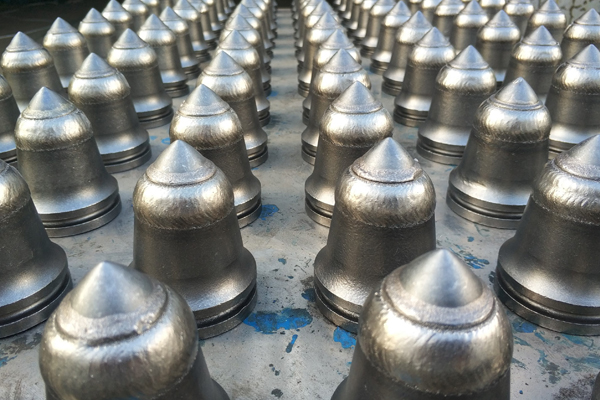WALKSON can provide specially formulated Tungsten Carbide Overlay (TCO) applied by Plasma Transferred Arc Welding (PTAW) process on any casting or fabrication part surface to increase the wear-resistant property of the part.
For extremely abrasive applications, the overlay properties in the following chart will be used. The lifecycle of this type of overlay by PATW welding is 5-6 times longer than Chrome Carbide Overlay. Typical Applications of this kind of overlay are Slurry line, slurry pump suction and discharge spool, wear spool, spray nozzles.
For heavy load applications, the tungsten carbide is 60-70 wt % and the balance is NiB matrix. The particle size of prime carbide is in the range of 60-325 mesh (44-250 micron) with hardness HV 2700-2900. The bulk hardness of NiB matrix is HRC 45-55.
This formula is designed for medium to heavy load application. The combination of high hardness of the prime carbide and high toughness of the matrix make the wear products excellent for high-impact applications. Its lifecycle is 5-6 times longer than AR plates.
Typical Applications of this kind overlay is Rotary screen wear plates, shovel teeth, crusher teeth and liner plates, grinder hammer tips, chutes/hoppers and mining picks.
WALKSON can provide specially formulated Tungsten Carbide Overlay (TCO) applied by Plasma Transferred Arc Welding (PTAW) process on any casting or fabrication part surface to increase the wear resistant property of the part.
For extremely abrasive applications, the overlay properties in the following chart will be used. The lifecycle of this type overlay by PATW is 5-6 times longer than Chrome Carbide Overlay.
Typical Applications of this kind overlay is Slurry line, slurry pump suction and discharge spool, wear spool, hammer tips, spray nozzles.
Overlay Properties | WC | Matrix |
Composition (wt%) | 70 -75 % | Balance |
Hardness | 2700- 2900 HV | 60-70 HRC |
Particle size (micron) | 44 - 250 | 53-198 |
Overlay Thickness (mm) | 3 - 15 mm | |
Bulk Hardness | 832 -1076 HV / 65-70 HRC | |
For heavy load applications, the tungsten carbide is 60-70 wt % and the balance is NiB matrix. The particle size of prime carbide is in the range of 60-325 mesh (44-250 micron) with hardness HV 2700-2900. The bulk hardness of NiB matrix is HRC 45-55.
This formula is designed for medium to heavy load application. The combination of high hardness of the prime carbide and high toughness of the matrix make the wear products excellent for high-impact applications. Its lifecycle is 5-6 times longer than AR plates
Typical Applications of this kind overlay is Rotary screen wear plates, shovel teeth, dragline teeth, crusher teeth and liner plates, grinder hammer tips, chutes/hoppers and mining picks.
Overlay Properties | WC | Matrix |
Composition (wt%) | 60 -70 % | Balance |
Hardness | 2300- 2600 HV | 45-55 HRC |
Particle size (micron) | 44 - 250 | 53-198 |
Overlay Thickness (mm) | 3 - 15 mm | |
Bulk Hardness | 720-865 HV / 61-66 HRC | |
WALKSON had been create milestone in the year 2021, we successfully applied PTAW Tungsten Carbide Overlay (TCO) on the valve sealing area with 8mm-12mm use stellite 6 cobalt base, this is the first successful trial with such thickness in china, WALKSON become the first company which can applied PTAW Tungsten Carbide Overlay (TCO) for the valve sealing field.

PTA stands for plasma transferred arc welding, which is a natural progression of the GTAW method. It's a simple-to-automate connection approach that produces higher-quality joins and welds by precisely controlling critical welding parameters. It's perfect for surfacing and cladding in heavy sectors including oil and gas, mining, and energy generation. Plasma transfer arc welding is a time-consuming and difficult joining method. It works by inducing a high-density plasma transfer arc, which has enough energy to melt the base metal workpiece and metal filler powder. The pilot arc is first created by ionizing inert gases (argon, helium, hydrogen, etc.) with the tungsten electrode and torch nozzle arc. By discharging plasma gas through the decreasing nozzle, the pilot arc is turned into a transfer arc. The plasma column is essentially throttled to a high temperature, a high jet velocity, and a high energy density.
[1] Plasma transferred arc welding—modeling and experimental optimization. [J] J. Wilden, J. P. Bergmann & H. Frank.
[2] Microstructure and wear properties of nickel-based surfacing deposited by plasma transferred arc welding. [J] Chen Guoqing, Fu Xuesong, Wei Yanhui, Li Shan, Zhou Wenlong. 15 August 2013, Pages S276-S282.
The main arc in TPAW is established between the tungsten electrode and the guide electrode. Compared with non-transferred plasma arc welding (NPAW) where one of the arc terminals is a nozzle, the workpiece is not connected to the circuit, and the energy loss is less than NPAW.
As the welding current and plasma gas flow rate increase, the diameter of the ablation zone of the TPAW (ie, the energy received by the workpiece) is much larger than the diameter of the NPAW. The MZ area and HAZ area of the TPAW weld are smaller, but the penetration depth of the PAW weld is similar.
Under the same parameters, the MZ or HAZ cannot be observed in the NPAW weld, indicating that the total heat input distribution of TPAW is much larger than that of NPAW . This trend provides a possible way to better control the energy of the plasma arc and expand the application of the plasma arc.

